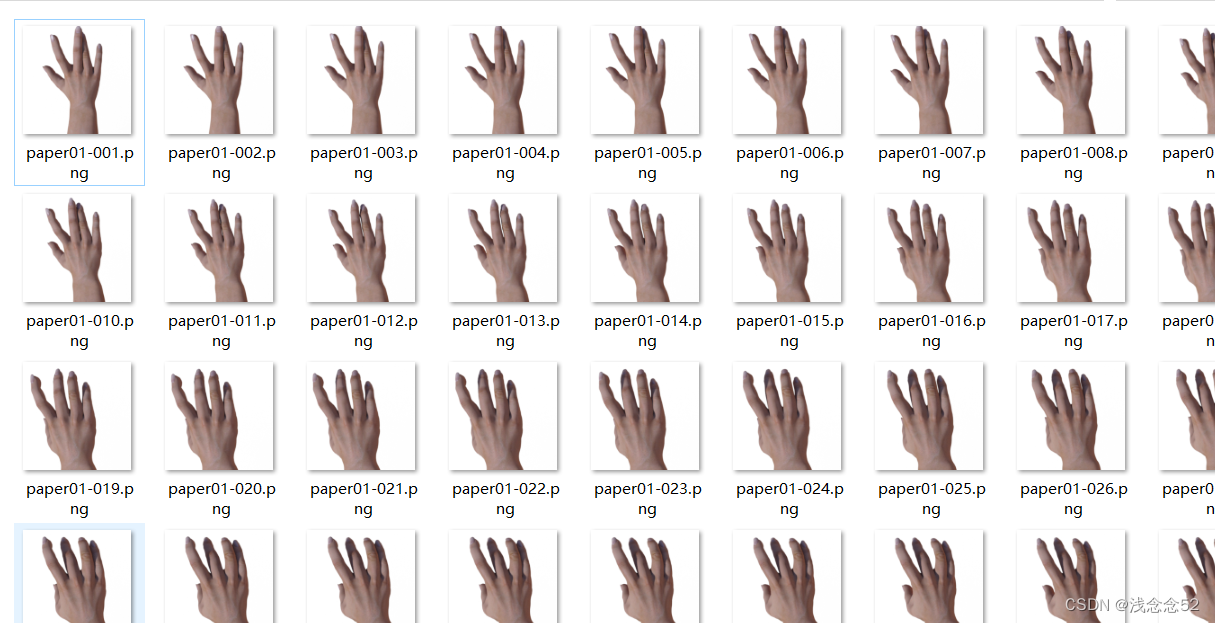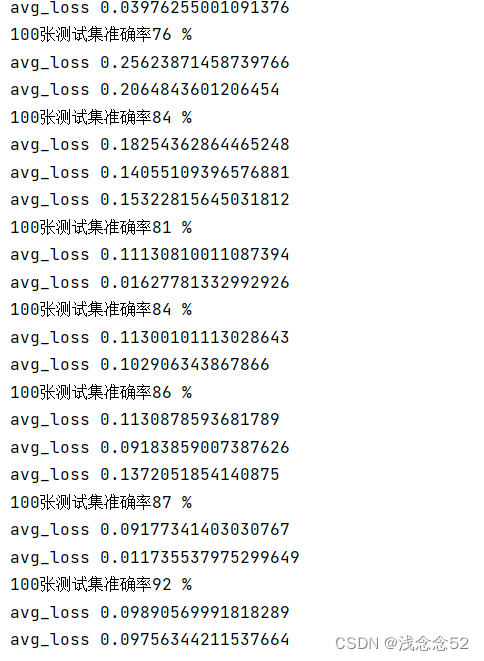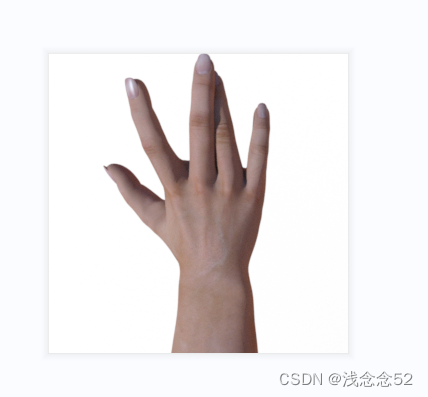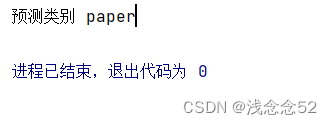文章目录
前言一、技术介绍二、实现途径三、总结
前言
上篇文章,讲了经典卷积神经网络-resnet,这篇文章通过resnet网络,做一些具体的事情。
一、技术介绍
总的来说,第一步首先要加载数据集,对数据进行一些处理,第二步,调整学习率一些参数,训练好resnet网络模型,第三步输入图片或者视频通过训练好的模型,得到结果。
二、实现途径
1.加载数据集,对数据进行处理,加载的图片是(N,C,H,W )对图片进行处理成(C,H,W),通过图片名称获取标签,进行分类。
train_paper=r'E:\桌面\资料\cv3\数据集\罚拳_公开\train\paper'train_rock=r'E:\桌面\资料\cv3\数据集\罚拳_公开\train\rock'train_scissors=r'E:\桌面\资料\cv3\数据集\罚拳_公开\train\scissors'test_paper=r'E:\桌面\资料\cv3\数据集\罚拳_公开\test\paper'test_rock=r'E:\桌面\资料\cv3\数据集\罚拳_公开\test\rock'test_scission=r'E:\桌面\资料\cv3\数据集\罚拳_公开\test\scissors'Batch_files=10transs=trans.Compose([ trans.ToTensor(), trans.Normalize((0.5,0.5,0.5),(0.5,0.5,0.5))])def read_img(batch_files): images=[] labels=[] for file in batch_files: image=Image.open(file) image=image.convert('RGB') image=image.resize((64,64)) tensor=transs(image) images.append(tensor) if 'rock' in file : labels.append(torch.tensor(0,dtype=torch.int64)) if 'paper' in file: labels.append(torch.tensor(1,dtype=torch.int64)) if 'scissors' in file: labels.append(torch.tensor(2,dtype=torch.int64)) return images,labelsif __name__ == '__main__':2.写入resnet模型:
这里用的是resnet18
class tiao(nn.Module): def __init__(self,shuru,shuchu): super(tiao, self).__init__() self.conv1=nn.Conv2d(in_channels=shuru,out_channels=shuchu,kernel_size=(3,3),padding=(1,1)) self.bath=nn.BatchNorm2d(shuchu) self.relu=nn.ReLU() def forward(self,x): x1=self.conv1(x) x2=self.bath(x1) x3=self.relu(x2) x4=self.conv1(x3) x5=self.bath(x4) x6=self.relu(x5) x7=x6+x return x7class tiao2(nn.Module): def __init__(self,shuru): super(tiao2, self).__init__() self.conv1=nn.Conv2d(in_channels=shuru,out_channels=shuru*2,kernel_size=(3,3),stride=(2,2),padding=(1,1)) self.conv11=nn.Conv2d(in_channels=shuru,out_channels=shuru*2,kernel_size=(1,1),stride=(2,2)) self.batch=nn.BatchNorm2d(shuru*2) self.relu=nn.ReLU() self.conv2=nn.Conv2d(in_channels=shuru*2,out_channels=shuru*2,kernel_size=(3,3),stride=(1,1),padding=(1,1)) def forward(self,x): x1=self.conv1(x) x2=self.batch(x1) x3=self.relu(x2) x4=self.conv2(x3) x5=self.batch(x4) x6=self.relu(x5) x11=self.conv11(x) x7=x11+x6 return x7class resnet18(nn.Module): def __init__(self): super(resnet18, self).__init__() self.conv1=nn.Conv2d(in_channels=3,out_channels=64,kernel_size=(7,7),stride=(2,2),padding=(3,3)) self.bath=nn.BatchNorm2d(64) self.relu=nn.ReLU() self.max=nn.MaxPool2d(2,2) self.tiao1=tiao(64,64) self.tiao2=tiao(64,64) self.tiao3=tiao2(64) self.tiao4=tiao(128,128) self.tiao5=tiao2(128) self.tiao6=tiao(256,256) self.tiao7=tiao2(256) self.tiao8=tiao(512,512) self.a=nn.AdaptiveAvgPool2d(output_size=(1,1)) self.l=nn.Linear(512,3) def forward(self,x): x1=self.conv1(x) x2=self.bath(x1) x3=self.relu(x2) x4=self.tiao1(x3) x5=self.tiao2(x4) x6=self.tiao3(x5) x7=self.tiao4(x6) x8=self.tiao5(x7) x9=self.tiao6(x8) x10=self.tiao7(x9) x11=self.tiao8(x10) x12=self.a(x11) x13=x12.view(x12.size()[0],-1) x14=self.l(x13) return x14第三步:调用读取数据函数,读取数据,打乱,开始训练:
train_rock=[os.path.join(train_rock,file) for file in os.listdir(train_rock)] train_paper= [os.path.join(train_paper, file) for file in os.listdir(train_paper)] train_scissors = [os.path.join(train_scissors, file) for file in os.listdir(train_scissors)] test_rock=[os.path.join(test_rock,file) for file in os.listdir(test_rock)] test_paper=[os.path.join(test_paper,file) for file in os.listdir(test_paper)] test_scission=[os.path.join(test_scission,file) for file in os.listdir(test_scission)] train=train_rock+train_paper+train_scissors test=test_rock+test_paper+test_scission random.shuffle(train) random.shuffle(test) model=resnet18().cuda() opt = torch.optim.ASGD(model.parameters(), lr=0.001, weight_decay=0.8) loss = nn.CrossEntropyLoss() print("开始训练")第四步:训练模型,完成后保存模型:
for i in range(5): running_loss=0 for index in range(0,len(train),Batch_files): images,labels=read_img(train[index:index+Batch_files]) inputs=torch.stack(images,0).cuda() labels=torch.stack(labels,0).cuda() inputs, labels = Variable(inputs), Variable(labels) opt.zero_grad() h=model(inputs) loss1=loss(h,labels) loss1.backward() opt.step() running_loss+=loss1.item() if index%41==40: avg_loos=running_loss/41 running_loss=0 print('avg_loss',avg_loos) if index%101==99: test_files=random.sample(test,100) test_image,test_label=read_img(test_files) test_images=torch.stack(test_image,0).cuda() test_labels=torch.stack(test_label,0).cuda() test_h=model(test_images) _,prediction=torch.max(test_h.data,1) total=test_labels.size(0) correct=(prediction==test_labels).sum() print('100张测试集准确率%d %%'%(100*correct/total)) torch.save(model.state_dict(),'resnet_caiq猜拳.pth')
第五步:加载模型,进行测试:
model.load_state_dict(torch.load('resnet_caiq猜拳.pth'))labels={0:'rock',1:'paper',2:'scissors'} images=[] image=Image.open(r'E:\桌面\1.png') image=image.convert('RGB') image=image.resize((64,64)) image=transs(image) images.append(image) image= torch.stack(images, 0).cuda() label=model(image) _,prediction=torch.max(label.data,1) print("预测类别",labels[prediction.item()])

三、总结
本文只是简单介绍了,通过pytorch训练resnet模型。调用训练好的模型,对图片,视频,摄像头进行检测。
本文只是简单对图片进行检测,得到预测结果。
在这里运用了resnet18模型进行训练,其实还有更好的模型,得到更好的训练结果。
在目标检测领域,最著名的是YOLO,检测速度非常快,在实时检测领域很受欢迎,在一些游戏上,可以通过YOLO脚本,实现自动锁定,追踪之类的,比如现在欢迎的吃鸡游戏,玩家通过脚本,实现自动识别人,进行射击操作。在yolov3中,作者提到过yolo已经运用到军事中,出于道德层面的考虑,作者暂停了yolo的更新,在这之后v4,v5,v6以及之后的版本都是一些大佬接棒的。
在实时检测中,现在AI在一些方面已经超越人类了,在准确率上虽然人脑的高层次演绎归纳能力是远胜于AI的,但是在低级信息处理速度和精确度上,人类就很难比得过专精某个功能的AI了。